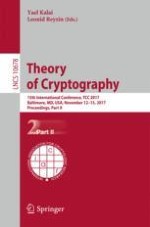2017 | OriginalPaper | Buchkapitel
Linear Secret-Sharing Schemes for Forbidden Graph Access Structures
verfasst von : Amos Beimel, Oriol Farràs, Yuval Mintz, Naty Peter
Erschienen in: Theory of Cryptography
Aktivieren Sie unsere intelligente Suche, um passende Fachinhalte oder Patente zu finden.
Wählen Sie Textabschnitte aus um mit Künstlicher Intelligenz passenden Patente zu finden. powered by
Markieren Sie Textabschnitte, um KI-gestützt weitere passende Inhalte zu finden. powered by
